Spanish/Mexican Language and Culture Kit
Charro: The Mexican Cowboy. Ancona, George. Harcourt, 1999. ISBN: 9780152010461. This photo-essay depicts the stories and practices around the charrera in Guadalajara, Mexico. A brief historical background is provided as well as information on the specific training required to become a charra or charro.
Day of the Dead/El día de los muertos. Barner, Bob. Teresa Mlawer, Ill. Holiday House, 2010. ISBN: 9780823422142. This rhythmic narrative explains how a family prepares for and celebrates the Day of the Dead; a Mexican tradition that honors and remembers those who are not among us anymore. Bright colors on a black background highlight the artifacts.
Diego. Winter, Jonah. Jeanette Winter, Ill. Random House 1991. ISBN: 9780679856177. The author and illustrator combine written text and visual images to create small masterpieces telling the story of the famous Mexican artist Diego Rivera.
The Diving Bell. Strasser, Todd. New York: Scholastic Press (1992). ISBN: 9780590430456. Set during the Spanish colonization of Mexico, a Mexican indigenous girl learns the Spaniards’ ways in order to save her brother and her community. Her relationships with the village monk and other Spaniards, explore different layers of trust, respect and loyalty among the colonized and colonizers in that time period.
El Cucuy! Hayes, Joe. Robledo, Honorio, Ill. Cinco Punto Press (2001). ISBN: 9780938317784. El cucuy is a traditional Mexican story about a man who lives in the mountains and kidnaps children who misbehave. Parents frequently share this story to teach social norms.
Elena’s Serenade. Geeslin, Campbell. Juan, Ana, Ill. New York: Atheneum, 2004. ISBN: 9780689849084. Elena learns to be a glassblower like her father when she travels to Monterrey to learn from master glassblowers. The story presents a Mexican practice that might be unknown to many.
Esperanza Rising. Muñoz-Ryan, Pam. Scholastic Press, 2009. ISBN: 9780439120425. Esperanza lives a wealthy lifestyle on a ranch in Mexico, until her father dies and she and her mother must cross the border in order to survive. Living as a migrant worker, she learns about being humble and hard working, as well as the importance of family and friendship.
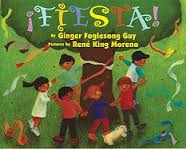 Fiesta/Fireworks. Ancona, George. Lothrop, Lee & Shepard (1998). ISBN: 9780688148171. Tultepec, Mexico is well known for the making of spectacular explosives and celebrations, especially during feast of day of San Juan de Dios. This book exposes children to the richness of Mexican culture in an urban area.
Fiesta/Fireworks. Ancona, George. Lothrop, Lee & Shepard (1998). ISBN: 9780688148171. Tultepec, Mexico is well known for the making of spectacular explosives and celebrations, especially during feast of day of San Juan de Dios. This book exposes children to the richness of Mexican culture in an urban area.
Frida. Winter, Jonah. Juan, Ana, Ill. Scholastic, 2002. ISBN: 9780590203203. This biography tells the story of Frida Kahlo, one of the most eccentric and emotive artists in Mexico. The illustrator plays with imagination and color to represent Frida’s way of thinking, living, and painting.
Funny Bones: Posada and His Day of the Dead Calaveras. Tonatiuh, Duncan. Abrams, 2015. ISBN: 97814119716478. Funny Bones tells the story of how the amusing calaveras—skeletons performing various everyday or festive activities—came to be. They are the creation of Mexican artist José Guadalupe (Lupe) Posada (1852–1913), best known for his literary calaveras, brief and amusing rhyming poems about skeletons dressed in clothes, going about their daily business.
Holy Molé! McAlister, Carline. Czernecki, Stefan, Ill. August House, 2007. ISBN: 9780874837759. In a monastery in a Mexican town, the orphan child who works in the kitchen prepares the famous Mexican mole for the first time using chocolate with turkey, spices, and nuts. The story is authentic but the illustrations are stereotypical and problematic.
Isabel’s House of Butterflies. Johnson, Tony. Guevara, Susan, Ill. Sierra Club, 2003. ISBN: 9781578051281. Every autumn, monarch butterflies migrate to the mountainous area of Michoacán, Mexico where Isabel and her family live, returning to roost in the single tree outside their house. When Isabel’s father decides that he must chop down the tree and sell its wood to buy food, Isabel comes up with a plan that gives her family hope and a way to spare the oyamel tree.
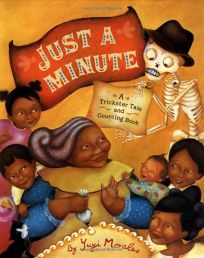 Just a Minute. Morales, Yuyi. San Francisco: Chronicle Books (2003). ISBN: 9780811837583. Framed in a Mexican context, Yuyi has created a funny and attractive character that represents the topic of death in a symbolic way. Señor Calavera visits Grandma Beetle because it is time for her to travel with him, but she has several things to do first, described numerically from 1 to 10.
Just a Minute. Morales, Yuyi. San Francisco: Chronicle Books (2003). ISBN: 9780811837583. Framed in a Mexican context, Yuyi has created a funny and attractive character that represents the topic of death in a symbolic way. Señor Calavera visits Grandma Beetle because it is time for her to travel with him, but she has several things to do first, described numerically from 1 to 10.
Just in Case. Morales, Yuyi. Roaring Brook Press (2008) ISBN: 9781596433298. On Grandma Beetle’s birthday, Señor Calavera tries to find the perfect present with the support of Grandpa Zelmiro. The collection of gifts creates a bilingual alphabet. The book is supported with highly emotive illustrations, which reveal that Grandma’s wish is to see her beloved husband.
La llorona/The Weeping Woman. Hayes, Joe. Hill, Vicki & Pennypacker. Mona, Ill. Cinco Punto Press 2004. ISBN: 9780938317395. La llorona is one of the most popular cuentos of Hispanic America. The weeping woman tells the scary story of a woman who lost her children and spent her afterlife searching for them. The story is often told to children to scare them into coming home on time at night.
La señora regañon. Sanromán, Susana. Domi, Ill. Fondo de Cultura Económica (1997) ISBN: 9780613280594. In this simple story, a frightened child keeps a light under her covers to scare away the night, which she calls Señora Regañona – Old Grouch. She has a dream that helps her learn not to be afraid of the moon. Written in Spanish.
Light foot/Pies ligeros. Toledo, Natalia. Toledo, Francisco, Ill. Groundwood, 2006. ISBN: 9780888997890. This intriguing fable is based on Francisco Toledo’s series of engravings of Death, a dominant figure in Mexican culture. Death, concerned by overpopulation in the world, decides to solve the problem by challenging everyone to a skip-rope contest where the losers die.

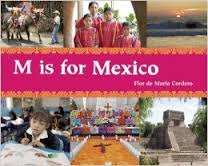 M is for Mexico. Cordero, Flor de Maria. Frances Lincoln Children’s Books, 2008. ISBN: 97818845075934. This alphabet book is filled with fabulous photographs of Mexico. The author/photographer captures the people, customs, and culture of her country both in historical and contemporary context.
M is for Mexico. Cordero, Flor de Maria. Frances Lincoln Children’s Books, 2008. ISBN: 97818845075934. This alphabet book is filled with fabulous photographs of Mexico. The author/photographer captures the people, customs, and culture of her country both in historical and contemporary context.
Mayeros: A Yucatec Maya Family. Ancona, George. Lothrop, Lee & Shepard, 1997. ISBN: 9780688134662. This photographic essay comes from the author’s own experiences growing up on the Yucatan Peninsula. The book depicts daily life for a modern Mayan Indian family engaged in practices associated with their Mayan heritage and the Spanish explorers.
My Big Book of Spanish Words. Emberley, Rebecca. Little Brown Kids, 2008. ISBN: 9780316118033. This colorful text introduces readers to colors, numbers, animals and much more. This is a perfect beginning bilingual book to help facilitate the learning Spanish.
My First Book of Proverbs/Mi primer libro de dichos. González, Ralfka. Ruiz, Ana, Ill. Children’s Book Press, 1995. ISBN: 9780613887991. This bilingual text presents a collection of popular sayings and proverbs from Mexico and other Latin-American countries. Children can identify the English version of each saying while learning about the importance of context in understanding these sayings.
My First Book of Spanish Words. Kudela, Katy. Capstone Press, 2009. ISBN: 9781429632984. How do you say hello in Spanish? Explore the pages of this Spanish English picture dictionary to learn new words and phrases. Colorful photographs and simple labels make learning Spanish fun.
The Piñata Maker/El piñatero. Ancona, George. Harcourt, 1994. ISBN: 9780152000608. One of Mexico’s most famous artifacts is piñatas, but many do not know the stories and experiences of how piñatas are made. Ancona takes us into the life of Don Ricardo Nuñez Gijon, or Tío Rico, a piñatero, who gives life to piñatas and to his own town.
Play and Learn Spanish. Lomba, Ann & Summerville, Marcela. McGraw-Hill, 2011. ISBN: 9780071759281. At the core of Play and Learn Spanish are 50+ everyday conversations between Spanish parents and their children. These conversations will help you fine-tune your ear to fluent, everyday Spanish that you can use. The book also has many songs and games, including two new board games at the end of the book.
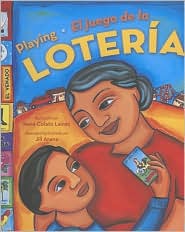 Playing Loteria/El juego de la lotería. Colato-Laínez, Rene. Arena, Jill, Ill. Luna Rising, 2005. ISBN: 9780873588812. While Mexican children today may not play La Lotería, the game was a common part of their parents’ childhood. This board game is similar to Bingo, but played with beans and cards with pictures of significant elements from Mexican culture. In the book, a Mexican-American child spends a summer in Mexico learning the language and the culture as he plays La Lotería with his beloved grandmother.
Playing Loteria/El juego de la lotería. Colato-Laínez, Rene. Arena, Jill, Ill. Luna Rising, 2005. ISBN: 9780873588812. While Mexican children today may not play La Lotería, the game was a common part of their parents’ childhood. This board game is similar to Bingo, but played with beans and cards with pictures of significant elements from Mexican culture. In the book, a Mexican-American child spends a summer in Mexico learning the language and the culture as he plays La Lotería with his beloved grandmother.
Princess and the Warrior: A Tale of Two Volcanoes. Tonatiuh, Duncan. Abrams, 2016. ISBN: 9781419721304. Award-winning author Duncan Tonatiuh reimagines one of Mexico’s cherished legends. Princess Izta had many wealthy suitors but dismissed them all. When a mere warrior, Popoca, promised to be true to her and stay always by her side, Izta fell in love. The emperor promised Popoca if he could defeat their enemy Jaguar Claw, then Popoca and Izta could wed. When Popoca was near to defeating Jaguar Claw, his opponent sent a messenger to Izta saying Popoca was dead. Izta fell into a deep sleep and, upon his return, even Popoca could not wake her. As promised Popoca stayed by her side. So two volcanoes were formed: Iztaccíhuatl, who continues to sleep, and Popocatépetl, who spews ash and smoke, trying to wake his love.
The Tree is Older than You Are: A bilingual Gathering of Poems & Stories from Mexico. Nye, Naomi Shihab. Simon & Schuster, 1995. ISBN: 9780689820878. A bilingual anthology of 102 poems and stories features the work of 64 Mexican writers and artists. Through their work, readers can delve into the rich culture of Mexican life.
Truth and Salsa. Lowery, Linda. Peachtree 2006. ISBN: 9781561453665. After her parents divorce, Hayley Flynn lives with her grandmother in San Miguel, Mexico for six months. Her experiences challenge her stereotypes about Mexican culture and the Spanish language. While struggling to find her place in this new context, Hayley empathizes with others and becomes active in the struggle for justice for migrant workers in Michigan.
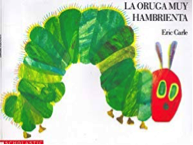 Very Hungry Caterpillar/La oruga muy hambrienta. Carle, Eric. Philomel, 2011. ISBN: 9780399256059. The time-honored classic The Very Hungry Caterpillar bilingual edition brings together two languages for a reading and learning experience. With easily readable side-by-side English and Spanish text, it’s perfect for children learning to speak either language.
Very Hungry Caterpillar/La oruga muy hambrienta. Carle, Eric. Philomel, 2011. ISBN: 9780399256059. The time-honored classic The Very Hungry Caterpillar bilingual edition brings together two languages for a reading and learning experience. With easily readable side-by-side English and Spanish text, it’s perfect for children learning to speak either language.
What Can You Do with a Rebozo? Tafolia, Carmen. Cordova, Amy, Ill. Tricycle Press, 2008. ISBN: 9781582462202. This book focuses on the creative ways that one family uses a rebozo–mother wraps her baby, sister dances la Bamba, younger brother plays superheroes, and father uses it to clean.

I would love to use this kit to teach more culture in my class.
Hi Rocio! Glad to see you’re interested in this kit. Are you local to Tucson? If so, you can request the kit here: http://wowlit.org/links/language-and-culture-resource-kits/kit-request/ Otherwise, we can get you an updated bibliography, so you can find the books at your local library. We try to select books that are widely available. -Rebecca